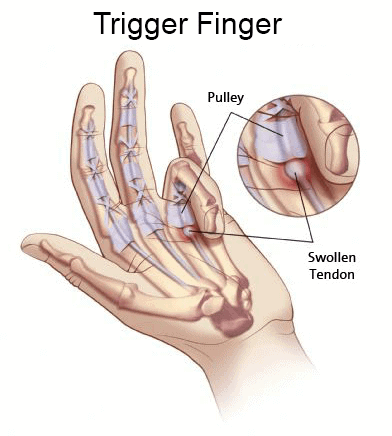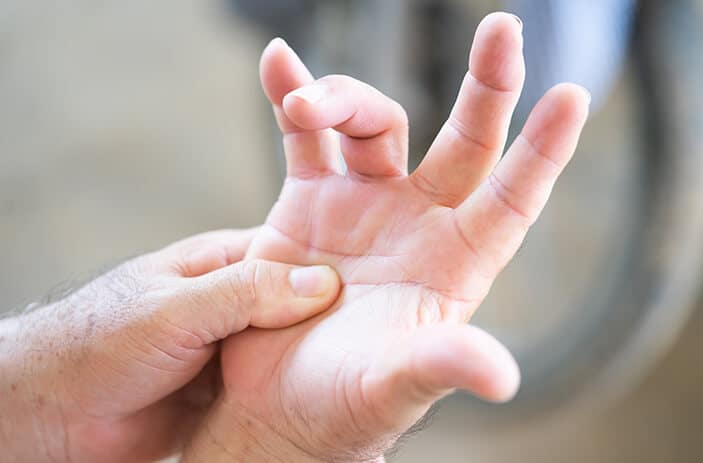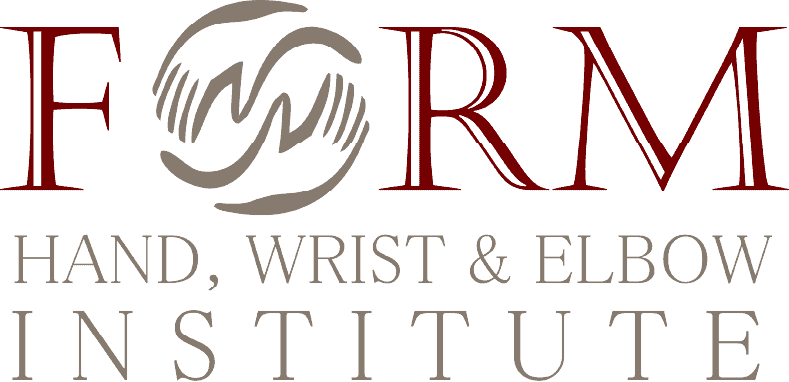Trigger Finger
Trigger finger or sclerosing tenosynovitis is a condition that affects the movement of the flexor tendon through the tendon sheath in one or more of the fingers.
Normally, the flexor tendon passes through the tendon sheath (a tunnel in the palm and fingers), allowing it to glide smoothly as the finger bends and straightens. Bands of tissue called “pulleys” located along the tendon sheath hold the flexor tendons closely to the finger bones. The tendons pass through the pulleys as the finger moves. The pulley at the base of the finger is called the “A1 pulley,” and this is the pulley that is most often involved in the trigger finger.
If the tendon becomes swollen from overuse such as grasping that occurs with typing or texting, the tendon has a difficult time moving through the tunnel. As a result, the finger with the affected tendon can become bent with a limited range of motion.
Most commonly, the ring finger and thumb are affected, but it can also occur in other fingers as well. If the thumb is involved, it is called trigger thumb.
What causes trigger finger?
The direct cause of trigger finger is not known; however, there are several factors that may increase your risk for developing the condition. These include:
- Medical conditions, such as diabetes and rheumatoid arthritis.
- Forceful use of the fingers and thumbs, such as pinching and grasping activities, can cause this condition to occur.

What are the symptoms of trigger finger?
Common symptoms of trigger finger include bent fingers, pain in fingers or palm of the hand, stiffness in fingers, a sensation of locking or catching when you bend and straighten your finger, and/or a swollen bump at the base of the finger.
How is trigger finger diagnosed?
Your hand doctor will review your medical history with you and ask you about your symptoms. Your doctor will also examine your hand for signs of tenderness over the flexor tendon sheath in the palm of your hand, thickening or swelling of the tendon sheath, and triggering when you bend and straighten your finger.

What is the treatment for trigger finger?
There are both nonsurgical and surgical treatment options available for trigger finger.
Nonsurgical Treatment
Trigger finger or sclerosing tenosynovitis can be treated with
- Rest. Resting your hand and avoiding activities that make the symptoms worse can help to resolve the problem.
- Splinting. Wearing a splint during the day or at night can help keep the affected finger or thumb in a straight position.
- Exercises. Gentle stretching exercises can help decrease stiffness and improve range of motion. Your doctor can refer you to physical therapy (hand therapy) to learn these stretching exercises.
- Medications. Over-the-counter medications, such as aspirin and ibuprofen, can help relieve pain and inflammation.
In more severe conditions, cortisone injections may be injected into the tendon sheath at the base of the trigger finger to resolve the triggering for several weeks. If two injections don’t help the problem, surgery may be considered.
Surgical Treatment
If nonsurgical treatment options don’t help resolve trigger finger symptoms, surgical options are available. The decision to have surgery is yours and depends on how much pain or loss of function you are experiencing in your finger. If your finger is stuck in a flexed or bent position, however, your hand doctor will recommend surgery to prevent permanent stiffness.
The surgical procedure for trigger finger is called tenolysis or trigger finger release. This procedure can be done on an outpatient basis using minimally invasive surgical techniques. The goal of the procedure is to release the A1 pulley that is blocking tendon movement so the flexor tendon can glide more easily through the tendon sheath.
What can you expect after trigger finger surgery?
After surgery, you will be encouraged to move your finger immediately. You may experience some soreness in your palm, which is normal.
Your incision will heal within a few weeks, but it may take 4 to 6 months for swelling and stiffness in your hand and fingers (or thumb) to go away completely.
If stiffness, swelling, or pain persist after surgery, you may be referred to physical therapy to see a hand therapist.
Trigger Finger Treatment in Fremont, California
If you are experiencing any symptoms of trigger finger, contact FORM Hand, Wrist & Elbow at (510) 480-3700 to schedule a consultation with Dr. Besh. Dr. Besh is an expert in upper extremity and hand conditions. He is fellowship-trained and has a subspecialty certificate in surgery of the hand. Your hands should be cared for by an expert with over 15 years of focused experience in orthopedic hand conditions. For your convenience, you may also request a consultation online.

